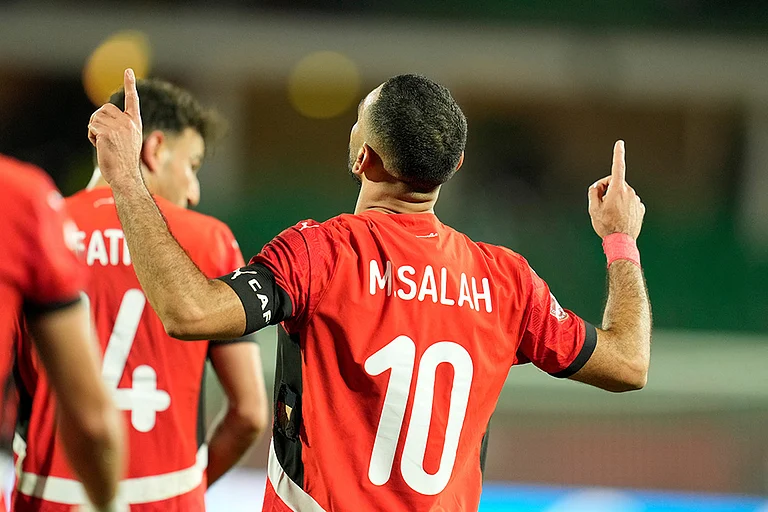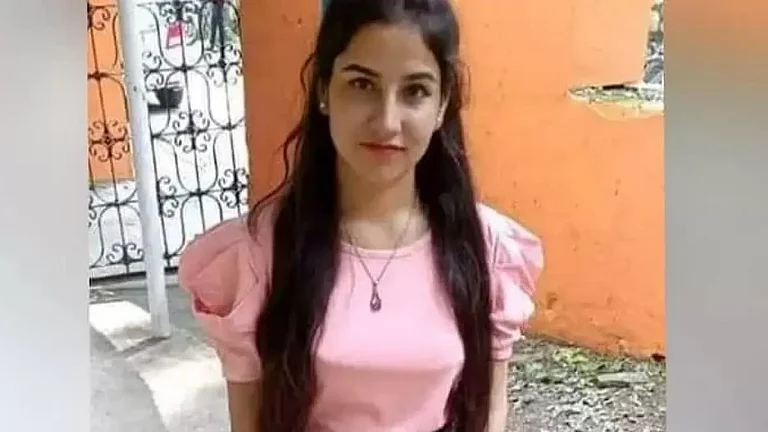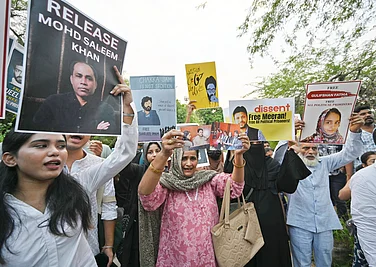A bucket of water kept inside the barely-lit, tiny kaccha house of Namsingh Singhar is the only ‘emergency supply’ for the four-member household. “The only source of water for us is the nearby hand pump. In summers, even that goes dry,” says Singhar, who belongs to the Bhil Adivasi community of Jhabua district in Madhya Pradesh that is all set to go to the polls on November 17.
Showing a tap that was installed a couple of months ago but has been inoperative since, the father of three sons and two daughters says, “It does not matter who comes to power. Nothing is going to change. We will have to struggle for roti, kapda and makaan.”
Singhar, who is in his mid-50s, has not received funds from the Pradhan Mantri Awas Yojana (PMAY) to make a pucca ghar. The Jal Jeevan Mission scheme—the central government initiative to supply tap water to every household—is yet to reach his house.
While two of his sons had to migrate to Gujarat as construction workers for better majdoori, one of them helps him in farming. With the decline in intergenerational wealth due to the increasing number of family members, they are now left with only one acre of land where they cultivate mostly corn and cotton. “Due to the lack of irrigation facilities, we can barely produce wheat. The corn produce is not sufficient for survival,” says Singhar, a resident of Chhoti Kheiru village that falls in the Petlawad Assembly constituency. However, two of his daughters-in-law are now getting Rs 1,250 per month through Shivraj Singh Chouhan’s Ladli Bahna Yojana—a scheme that a few consider could prove to be a game-changer for the BJP, which is reeling under the anti-incumbency factor.

Singhar is just one among lakhs of Adivasis from Bhil, Gond, Kol, Kurku, Sahariya, Baiga and several other tribes who are considered as the kingmakers of the state due to their formidable population of 21.1 per cent, as per the 2011 census. From Malwa-Nimar and Mahakoshal to the Vindhya region, the condition of the Adivasis has hardly improved in the past two decades. “Everyone was busy making profiles. The Adivasis were mostly being used as a vote bank throughout,” says Virendra Singh Rathore, a senior journalist who has been covering Western Madhya Pradesh for years.
The strongest evidence of such negligence is found in the recently-released reports of the multi-dimensional poverty index. As per the reports, Jhabua—commonly known as the Adivasi capital of the state—is the poorest of all in MP with 49.6 per cent people found to be multi-dimensionally poor. Among the top-ten poorest districts in the state, six have more than 70 per cent Adivasi population.
In Madhya Pradesh, among the 230 Assembly seats, 47 are reserved for the STs. However, there are at least another 35 seats where Adivasis have more than 60,000 votes, points out Anand Rai, senior leader of Jay Adivasi Yuva Shakti (JAYS)—one of the major Adivasi pressure groups in western MP’s tribal-dominated Malwa-Nimar region.
If one studies the trend in the last decades, it is seen that whoever gains the majority in the above-mentioned 47 seats, forms the government. Though the BJP gained massively in the Adivasi-dominated seats in 2003, 2008 and 2013, in 2018, the Congress won 31 out of the 47 seats and formed the government. It is for this reason that the two parties are wooing Adivasi voters and have reserved their heavyweight campaigners for Malwa-Nimar, Mahakoshal and the Vindhya—the regions where the majority of the population belongs to the Bhil, Gond and Kol Adivasi communities, respectively.
Priyanka Gandhi’s consecutive rallies at Mandla and Dhar followed by Prime Minister Narendra Modi’s visits to Jabalpur and Seoni—the Adivasi-dominated districts—make it clear that all the parties are taking the tribal votes seriously. The Congress has, in fact, recruited its former Union Minister and senior Adivasi leader Kantilal Bhuriya from the Malwa-Nimar region as the head of its campaign.
While the BJP, for the past couple of years, has been evoking the legacies of popular Adivasi leaders like Raja Shankar Shah, his son Raghunath Shah and Tantya Bhil, among others, the people allege that the conditions of the Adivasis have not improved. On November 15, 2021, on the occasion of legendary Adivasi leader Birsa Munda’s birth anniversary, PM Modi changed the name of Bhopal’s Habibgunj railway station to Rani Kamalapati, evoking the legend of Bhopal’s Gond queen.
The ruling party is also banking on Chouhan’s initiative of providing doorstep delivery of monthly rations to 89 tribal blocks across the state. The other issues that the BJP is focusing on in its Adivasi campaign trail are the projected successes of PMAY, Jal Jeevan Mission (JJM), Ujjwala Yojana as well as other state-level women-centric schemes like Ladli Bahna Yojana.

However, different Adivasi pressure groups claim that the funds from the Tribal sub-plan are being diverted to non-tribal schemes. “The Tribal Advisory Council (TAC), which is a designated body to take decisions on the matter of tribals in the state, has been inoperative for years. Since its constitution in 2021, it has rarely held any meeting,” says Rai. The data from the Ministry of Tribal Affairs shows that between 2012 and 2017, the state didn’t convene a single TAC meeting.
As the BJP is banking on its promises of strengthening Gram Sabha in the Fifth Schedule areas, Priyanka Gandhi has promised to recommend the inclusion of Adivasi districts with more than 50 per cent tribal population into the Sixth Schedule. While the debates on the Fifth Schedule, PESA and its implementation dominated the political rhetoric, roti, kapda and makaan have taken a backseat.
When Outlook visited the Adivasi-dominated Malwa-Nimar and Mahakoshal region, the issues that impact everyday lives take centre stage. The Adivasis want the political parties to address issues like the water crisis, agricultural distress, migration, unemployment, unsuccessful implementation of government schemes and the incidents of atrocities directed at them. Though MLAs from both the parties touch upon a few of these issues, they are certainly missing from the larger narrative during the MP election.
Water and Irrigation Crisis
On a sunny afternoon, Haqri Damor, a resident of Shyamalia Bara, a small Adivasi village comprising 1,200 people in Jhabua, the poorest district of the state, is busy fetching water. The hand pump is the only one in the vicinity. She wipes the trickle of sweat from her forehead and says: “It is really difficult to get water now. In summers, this hand pump goes dry. I have to walk at least three km to reach the nearby talab.”
“They told us that a pipeline would be laid and we would get tap water but it never happened,” says Damor, a mother of three sons—two left for Gujarat as they were getting decent salaries as construction workers. While taps have been installed in some houses in nearby villages, they are not operational.
The numbers tell a different story. As per the government data, since the beginning of JJM, 52.49 lakh—53.22 per cent—targeted households have been brought into its ambit in Madhya Pradesh. The data also shows that the percentage of households with tap water supply in Jhabua stands at 57.8 per cent.
Around 100 km away from Damor’s village, at Limdapura in Dhar district, stays Raju Singh Damor, with his wife and three children. He, along with many others, still don’t have tap water or irrigation facilities. But the government data shows that 72.6 per cent of the households in Dhar have piped water connections. “We don’t get tap water. We don’t have access to proper irrigation facilities. The lack of water affects our farming prospects,” laments Raju. Jhabua, Alirajpur and Dhar districts have been facing the crisis of irrigation for years.
In 2018, the government initiated a Rs 2,050 crore project named Narmada-Jhabua-Petlawad-Thandla-Sardarpur Micro Lift Irrigation Scheme that was supposed to serve 202 villages in these districts. The target of completion of the project was 2021. The locals claim it has not even started.
While some villages in Seoni district of Mahakoshal region get water for a few hours in a day, people miss it as they are out in the farms. Leelawati Devi, a resident of Shimriya village in Barghat Assembly constituency of Seoni district, says: “If it comes around noon and I am out on the field, I miss it. And then I have to struggle for water.” Irrigation is also a big issue in this region. “Despite the presence of the Machagora Dam, the people of Seoni are not getting enough water for irrigation. They say that the height of the land is responsible but the the micro lift irrigation is always a possibility,” says Zakariya Khan, a local journalist.
Agricultural Distress
The lack of water and irrigation facilities has led to agricultural distress in this region. In Bhurukam village of Amarwada constituency in Chhindwara district, Shivcharan Inwati, a Gond Adivasi in his mid-30s, is getting ready for the day, but the apprehensions of loss in the upcoming season loom large. “Last monsoon, I had to bear losses in corn production. But I never received any compensation. I don’t know what will happen this time,” says Inwati.
Explaining how the absence of irrigation facilities affects the prospects of wheat production, he says: “Wheat crops need water and unless we get enough water, our production is limited to corn.” The rising prices of urea and seeds are other challenges.
Though at a rally in Seoni district on November 5, PM Modi said that farmers are getting a sack of urea at less than Rs 300, the ground experiences of farmers tell a different story. While the farmers in Bhurukam village of Chhindwara buy a sack for Rs 450, in Seoni, farmers are spending Rs 420.
Kailash Wickey, a panchayat Samiti member of Vijaypani, a village in Seoni district, just 50 km away from where Prime Minister Modi referred to the reduced price of urea, says: “People here are buying urea for Rs 420-450 per sack. Though one bori is supposed to have 50 kg urea, in reality, it is less than 45 kg.”
In the Malwa-Nimar region, farmers are facing other issues. Mohan Singh Damor, a resident of Jhabua district, says: “We get urea at Rs 277, but the samiti limits it to four boris. We need at least 10 sacks for our six-acre land.” The limit on purchase imposed by the Panchayat Samiti has led to a fall in agricultural production of the Damor family.
A few km away from his house, Jam Singh Damor, a farmer in his late 50s, says that the rising price of the seeds has become a major issue for them. “Earlier, we used to buy a bag of 450 grams of cotton seeds for Rs 800. Now, we have to pay around Rs 3,000,” says Singh. While the increasing price of seeds is leading to higher input costs, the minimum support price (MSP) is still not enough for them to survive. “If I sell my crops in the village, I get around Rs 1,700-1800 per quintal of wheat. To get around Rs 2,000 per quintal, I have to take it to Amarwada,” says Inwati.
Just ahead of the elections, the central government increased the MSP by Rs 150 per quintal—the highest leap since 2007-08. In its electoral manifesto, the Congress has promised an MSP of Rs 2,600 per quintal for wheat and Rs 2,500 for paddy. The party has also promised a waiver of farm loans and electricity bills for farmers. “In the 2019 bypoll, the Congress got back a few seats that they had lost in 2018 to the BJP, thanks to its farm loan waiver policy,” says Rathore.

Vacant Villages
Agricultural distress, coupled with a lack of work opportunities, pushes the villagers of the Malwa-Nimar region to the nearby state of Gujarat. Mass migration has always been a major issue in the region, but none of the major political parties has addressed it.
Kailash Damor, a resident of Alirajpur district, says while boarding a tourist bus to Jamnagar in Gujarat where he would work at a construction site: “We have no option but to leave our villages. The wages are too low in our region.” In western Madhya Pradesh, construction workers get Rs 200-300 a day while a mason gets around Rs 500. “The same work helps us earn Rs 700-800 a day in Gujarat,” he adds.
Apart from higher wages, there are three reasons behind the large-scale migration—the decline in intergenerational wealth, agricultural distress, coupled with the water crisis, and marriage loans. “Among Bhils, as per the tradition, the groom has to pay a certain sum to the bride’s family before getting married. To repay the loan, several youths leave for Gujarat after marriage,” says a villager.
Arjun Singhar, 21, a resident of Dhar district, is about to leave for Gujarat after the corn crop is harvested. “I got married last year. I had to pay Rs 2.75 lakh. I took a loan and now I have to repay it,” says Singhar. When asked whether his wife will accompany him, he nods in the affirmative.
Mass migration has led to many villages turning into ghost villages—Putlibaoli, a village in Manawar constituency of Dhar district is one such village. One can only see some scattered rubble amidst the dense green. Ajay Maurya, a teenager from nearby Chirakhan village, says, “Five years ago, it used to be a proper village. My aunt used to stay here. There were around 200 families. Now all of them have migrated to different places.” While referring to land acquisition by a cement factory in 2015, Maurya adds: “As they took away the majority of the land, the people were left with almost nothing and had to leave for majdoori.”
The land acquisition by the cement giant is a contentious issue in this constituency. In 2014-15, the company acquired land from 32 villages. They promised the people jobs and three-times compensation. But what they got was only Rs 3 lakh per hectare.
“Only seven people from this constituency got jobs in the factory,” says Lal Singh Barman, who is fighting this election on an Aam Aadmi Party (AAP) ticket from Manawar. He is fighting for the people so they get back their dues. He belongs to JAYS, the Adivasi pressure group which for almost a decade had formidable dominance in the Malwa-Nimar region.
In 2018, JAYS leader Hiralal Alawa won an MLA ticket from the Congress, banking on the promise that he would force the cement company to return the land to the original owners. “He also promised that the people of his constituency would get jobs. But when he became an MLA, he forgot about us. He does not even take our calls. There is no proper road, school or hospital in the region. Alawa simply accumulated his own wealth,” says Kalu Singh Solanki, an Adivasi youth from the constituency.
In 2018, the wealth Alawa declared to the Election Commission was around Rs 10 lakh. But local media reports and the opposition camp allege it is a lot more now. Raju Solanki, a resident of Limtapuri village in Manawar, says, “We believed in promises made by Alawa and gave away our land. Humare saath dhoka hua hai (We have been duped).” Outlook tried to reach Alawa and the cement giant, but they were not available for comment.
Around 100 km away from Manawar, at Petlawad, people complain of not having a single hospital with facilities to provide tertiary medical care. Most of the people have to go to Gujarat’s Dahod for treatment. “In 2021, my daughter-in-law met with an accident and we had to take her to Dahod for treatment. We had to arrange Rs 2.5 lakh,” says Bulu Singhar, a resident of Bada Khairu village.
Missing Schemes
While the Adivasis of the Malwa-Nimar region have been grappling with issues like migration and the lack of medical facilities for some time now, even central government schemes like PMAY and Ujjwala Yojana that the BJP has been boasting of for years, are barely visible on the ground. Most of the houses across villages are kaccha. Very few are made of bricks and mortars and people have spent from their own pockets. “Our son sent us money from Gujarat and we built our pucca house,” says Sunita Devi of Alirajpur district.
As per government data, more than five lakh houses were constructed under PMAY in 2021-22. The number was much less in 2020-21—2.62 lakh. Bhanu Bhuriya, the BJP Adivasi leader and MLA contestant from Jhabua constituency, says: “We will get more than 40 seats in the ST-reserved seats this time as we have given people pucca houses.”
While most of the people have received cooking gas cylinders—known as tanks locally—they continue to use chulah. “We have to pay Rs 947 for filling the tanks up and it is too much for us,” points out Haqri Damor while readying her chulah. While this is the primary reason why people use chulah, Shivcharan Inwati’s mother had an interesting take. “One cannot make makki ki roti on a gas stove! It needs chulah!” Shivcharan adds: “It does not taste as good when made on a gas stove!” Notably, both the parties have made poll promises to bring down the cost of LPG cylinders to Rs 450-500.
The Swachh Bharat mission has also met limited success in most Adivasi-dominated districts, claim the locals. Thawariya, a resident of Alirajpur, says, “I invested Rs 2.5 lakh for making a toilet.” In some villages, toilets are not operational due to poor quality and lack of water. Interestingly, most of these districts have been given the Open Defecation Free (ODF) status, says a local reporter.
Atrocities Against Adivasis
While all the above-mentioned issues are going to play a huge role in the elections, atrocities against Adivasis will lead the pack. In an interview to Outlook, Kamal Nath said: “As per the NCRB data, Madhya Pradesh is at the top when it comes to cases of violence against Adivasis.” As per the data, attacks on Adivasis in Madhya Pradesh increased by 25 per cent in 2020.
Though after the recent incident in Sidhi, where a close aide of a BJP MLA urinated upon an Adivasi man, Chouhan washed his feet and promised him a house, political parties have majorly forgotten previous cases.
Phulwati Devi, the widow of Dhanshah Inwati, who was dragged out of his house and brutally lynched by a mob of 16-18 people allegedly belonging to the Bajrang Dal for “storing beef”, says, “In all these years, nobody came to us. We received a compensation of only around Rs 8 lakh.”
Standing in front of the mud house from where her husband had been taken on that horrific night of May 2021, she continues, “We didn’t even get a pucca house even after several promises.” Inwati, along with his neighbour Sompat Batti, were killed by the mob but a few arrests had been made, says Kailash Wickey, an Adivasi activist, who runs a pressure group named Birsa Brigade. “Under political pressure, they arrested 17 people, but gradually all but three got bail and are now roaming around freely.” While narrating her story, Phulwati was trying to hide her tears from the camera. Around 60 kms from her house, PM Modi was addressing a rally. These incidents were obviously not mentioned. The tears of Phulwati and many others are now ready to write the fate of Madhya Pradesh in the coming days.
(This appeared in print as ‘The Silent Stakeholder’)
Abhik Bhattacharya in Malwa-Nimar and Mahakoshal



























